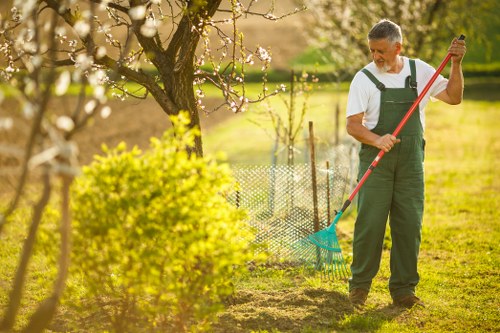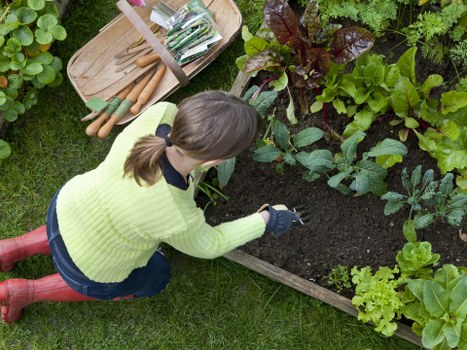Grass Cutting in Garden Fence Installation
Introduction to Grass Cutting and Fence Installation

When embarking on a garden fence installation, one crucial aspect that often gets overlooked is grass cutting. Proper grass maintenance ensures not only the longevity of your fence but also enhances the overall aesthetic appeal of your garden.
Maintaining a well-trimmed lawn around your fence provides a clean and organized look, making your outdoor space more inviting. Additionally, regular grass cutting prevents overgrowth that could potentially damage the fence structure over time.
In this article, we will delve into the importance of integrating grass cutting into your garden fence installation process, offering valuable tips and best practices to achieve a harmonious and sustainable garden environment.
Benefits of Regular Grass Cutting

Aesthetic Appeal: Regularly trimmed grass keeps your garden looking neat and well-maintained. It highlights the features of your fence, making it a focal point rather than an afterthought.
Structural Integrity: Overgrown grass can trap moisture against the fence, leading to rot and decay, especially in wooden fences. Keeping the grass cut reduces these risks, extending the life of your fence.
Easy Maintenance: Shorter grass makes it easier to perform routine maintenance on your fence, such as painting or repairing any damages. It also allows for better visibility of the fence condition.
Planning Your Garden Fence Installation

Before installing a new fence, it's essential to assess the current state of your garden, including the grass height and overall landscape layout. This pre-installation planning ensures that your fence integrates seamlessly with the existing environment.
Choosing the Right Fence Material: Different materials interact with grass growth differently. For instance, wooden fences may require more frequent grass cutting to prevent stains and decay, whereas vinyl fences are less susceptible to these issues.
Fence Height and Grass Interaction: The height of your fence can influence how you manage grass around it. Taller fences might require more strategic grass cutting patterns to maintain visibility and access, while shorter fences can be integrated more naturally into the grass.
Techniques for Effective Grass Cutting

Implementing the right grass cutting techniques can make a significant difference in both the appearance and health of your garden fence. Here are some key methods:
- Regular Mowing Schedule: Establish a consistent mowing schedule to keep grass at an optimal height, typically between 2 to 3 inches.
- Edge Trimming: Use an edger to maintain clean lines where grass meets the fence, enhancing the overall look.
- Mulching: Mulch clippings can be left around the fence to provide nutrients to the soil, but ensure they do not accumulate and cause moisture-related issues.
Adopting these techniques will not only keep your grass under control but also ensure that your fence remains in excellent condition for years to come.
Garden Design Considerations

A well-designed garden takes into account the interplay between grass and structural elements like fences. Here are some design tips:
- Pathways and Gates: Ensure that grass cutting around pathways and gates is meticulous to prevent obstruction and maintain accessibility.
- Plant Selection: Choose plants that complement your fence and require similar maintenance routines, simplifying overall garden care.
- Lighting: Proper lighting can highlight your fence and grass areas, reducing the need for excessive cutting by creating visually balanced spaces.
Integrating these design elements creates a cohesive and manageable garden space, where the fence serves both functional and aesthetic purposes.
Tools and Equipment for Grass Cutting
Choosing the Right Mower
Selecting the appropriate mower is essential for effective grass cutting around your fence. Options include:
- Electric Mowers: Ideal for smaller gardens, providing quiet and eco-friendly operation.
- Gas-Powered Mowers: Suitable for larger areas, offering more power and mobility.
- Manual Reel Mowers: Best for precision cutting in areas with intricate fence designs.
Additional Tools
Complement your mower with tools like string trimmers, edgers, and mulching attachments to enhance grass cutting efficiency and fence maintenance.
Seasonal Grass Cutting Tips
Spring and Summer
During the growing seasons, grass tends to grow more rapidly. Increase the frequency of mowing and ensure that your equipment is well-maintained to handle the lush growth.
Autumn and Winter
As growth slows, reduce mowing frequency but still maintain a regular schedule to prevent grass from becoming too long, which can harbor pests and diseases near the fence.
Adapting your grass cutting routine to seasonal changes ensures the health of both your lawn and fence throughout the year.
Common Challenges and Solutions
Overgrowth and Weed Control
Preventing overgrowth and controlling weeds near your fence requires consistent grass cutting and the use of appropriate herbicides. Regular maintenance makes it easier to manage these issues effectively.
Moisture and Drainage
Ensure proper drainage around your fence to prevent moisture buildup, which can lead to grass rot and fence deterioration. Proper grass cutting aids in water dispersion, reducing the risk of such problems.
Pest Management
Maintaining a tidy lawn discourages pests from taking residence near your fence. Regular grass cutting removes hiding spots and makes it easier to spot and address any pest issues promptly.
Integrating Sustainable Practices
Eco-Friendly Grass Cutting
Opt for electric or manual mowers to reduce carbon emissions and minimize environmental impact. Mulching instead of bagging grass clippings returns nutrients to the soil, promoting healthy grass growth.
Water Conservation
Implement efficient watering practices, such as drip irrigation, to maintain healthy grass while conserving water. Proper grass cutting also reduces water needs by minimizing evaporation and runoff.
Recycling and Composting
Recycling grass clippings through composting enriches the soil and reduces waste, contributing to a more sustainable garden ecosystem.
Hiring Professional Services
When to Consider Professionals
If managing grass cutting and fence installation becomes overwhelming, hiring professionals can ensure that both tasks are performed efficiently and to a high standard.
Benefits of Professional Services
- Expertise in selecting the right materials and techniques for fence installation.
- Efficient and thorough grass cutting, ensuring optimal lawn health.
- Time and effort savings, allowing you to enjoy your garden without the hassle.
Investing in professional services can enhance the quality and longevity of your garden fence and lawn maintenance.
Conclusion
Integrating grass cutting into your garden fence installation process is essential for maintaining a beautiful, functional, and durable outdoor space. By following the tips and best practices outlined in this article, you can achieve a harmonious balance between your lawn and fence, ensuring that both elements complement each other effectively.
Remember, regular maintenance is key to preventing issues and extending the life of your garden fence. Whether you choose to tackle these tasks yourself or hire professionals, prioritizing grass cutting will enhance the overall appeal and functionality of your garden for years to come.
Contact us today to learn more about our garden maintenance and fence installation services, and let us help you create the perfect outdoor space.